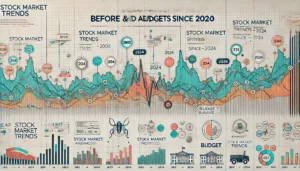The Union Budget is one of the most anticipated events in the Indian financial calendar. Each year, the Finance Minister presents this detailed statement, including the nation’s revenue and expenditure. However, parliament sessions are not just about fiscal policies and allocation of resources; they are also significant for their profound impact on the stock market. Let’s dive deep into stock market trends before and after budgets since 2000 and understand how market sentiments have evolved over the past two decades.
The Pre-Budget Market Sentiment
Investors tend to exhibit a mixture of excitement and anxiety in the run-up to the Union Budget. The anticipation can move the markets in unique ways. Below are some consistent trends observed during the pre-budget phase:
Speculation and Volatility
During the weeks leading up to the budget announcement, the stock market usually experiences higher levels of speculation and volatility. This is driven by:
- Expectations around tax reforms and sector-specific incentives.
- Forecasts regarding fiscal deficit targets and government borrowing.
- Uncertainty about potential regulatory changes.
Historical Performance
A quick look at historical data reveals that benchmark indices like the Sensex and Nifty have frequently moved upwards. Investors hope to capitalize on speculative trades, driven by the expectations of favourable policies.
The Post-Budget Reaction
Once the budget is announced, the market’s reaction typically provides a more sober reflection of the budget’s actual impact. Let’s look at the constituent elements that affect post-budget market behaviour:
Immediate Market Reaction
The first few hours post-budget are crucial:
- Markets either see a spike or dip based on initial sentiment.
- Traders and investors adopt a “buy on rumour, sell on news” approach.
Short-term Adjustments
Shortly after the initial reaction, markets begin a phase of short-term adjustments, driven by detailed scrutiny of the budget specifics:
- Analysts pore over fine print to understand actual policy, taxation, and subsidy details.
- Sectors predicted to benefit from the budget often see a surge in their respective stocks.
- In contrast, sectors facing unfavourable regulations experience a decline.
Case Studies: A Year-by-Year Breakdown Since 2000
Let’s delve deeper into some noteworthy years which exemplify these trends:
2003: A Turning Point
The 2003 budget presented by then Finance Minister Jaswant Singh was focused on infrastructure. The markets responded positively, seeing this as a growth-oriented budget. The BSE Sensex saw a significant rise from 3,040 in January 2003 to 5,634 by the end of the year.
2008: The Global Financial Crisis
Budget 2008 couldn’t escape the shadows of the global financial crisis. Delivered by P. Chidambaram, it offered tax rebates and aimed at stimulating demand. Despite these measures, the markets plunged; the Sensex fell from around 18,000 points to 8,700 by the end of the year.
2014: Modi Government’s Inaugural Budget
In July 2014, Arun Jaitley presented the first budget of the newly elected Modi government. Focused on economic reforms, simplification of the tax structure, and launching the Make in India campaign, the budget sent a positive signal. The Sensex climbed from around 25,000 to 29,000 by March 2015.
2020: The Pandemic Budget
Nirmala Sitharaman had a mammoth task in 2020. Her budget focused on supporting an economy grappling with COVID-19. Despite comprehensive measures, the initial market response was tepid. However, as the year progressed, the Sensex bounced back significantly, closing above 47,000 points by December 2020.
Summing Up the Trends
Understanding stock market trends before and after budgets can offer valuable insights. A quick recap of the observed tendencies:
- Pre-budget periods often exhibit heightened volatility and speculative trading.
- Immediate market reactions post-budget are frequently based on sentiment rather than detailed analysis.
- Short-term adjustments allow for more rational market behaviours as the specifics of the budget are scrutinized.
- Major economic events, such as international crises or pandemics, can dramatically alter usual trends.
Optimizing Investment Strategies Around Budgets
While past performance may not guarantee future results, some guiding principles can be drawn from historical data:
- Consider a balanced portfolio to hedge against pre-budget volatility.
- Analyze sector-specific announcements to identify potential market movers.
- Stay informed but avoid panic selling; post-budget corrections are normal and offer opportunities for strategic investments.
Conclusion
The reaction of stock markets before and after Union Budgets since 2000 showcases a complex web of emotions, speculation, and strategies. Financial markets have a nuanced relationship with budgetary announcements, influenced by both macroeconomic conditions and investor sentiment.
When engaging in stock market investments, it is crucial to maintain a balanced perspective. Given the historical data, understanding past reactions can provide a foundational strategy, but flexibility and continual learning remain essential.





